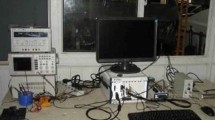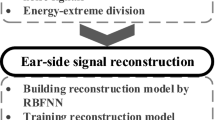Abstract
Interior noises of vehicles would be caused when the vibration of body panels excites the indoor air. In the paper, the vibration load of engine was obtained firstly through experiments. Secondly, the engine load was applied in the finite element model of body in white to compute the vibration velocity and realize virtual reality, indicating that the front support of the body had large vibration velocity when the frequency was lower than 60 Hz. The boundary element was then adopted to compute the interior noise and extract the sound pressure at a point near the driver’s head. Two obvious peaks were shown in sound pressure curves, at 270 and 310 Hz, respectively. The body panels that had obvious impact on the interior peak noise were determined through the panel contribution analysis, and the interior peak noise was remarkably reduced after applying sound absorption materials on these panels. Nevertheless, many more additional sound absorption materials were not always better. If a multilayer of sound absorption materials was needed, an optimal value was existed in the thickness of sound absorption material. And a great impact would be played toward the interior noise of the cabin by the reasonable selection of different sound absorption materials and their thicknesses. Finally, the neutral network (NN) was also used to predict interior noises, which was compared with the result of the boundary element. The maximum difference between the prediction values of NN and boundary element was within 5 dB, indicating that the neural network was feasible to predict the interior noise. Subsequently, the neural network method would be applied to conduct the optimization analysis for the interior noise.















Similar content being viewed by others
References
Grosso A, Comesana DF, De Bree HE (2012) Further development of the PNCA: new panel noise contribution reference-related (PNCAR). SAE Int J Passeng Cars-Mech Syst 5:1101–1106
Kim KC, Kim CM (2007) Process of designing body structures for the reduction of rear seat noise in passenger car. Int J Autom Technol 8(1):67–73
Hald J, Mørkholt J (2009) Panel contribution analysis in a vehicle cabin using a dual layer handheld array with integrated position measurement. SAE Int J Passeng Cars-Mech Syst 2:1458–1469
Zhang ZF, Ni XS, Xu ZM (2011) Modal characteristics improvement of a commercial vehicle cab based on structural optimization. Autom Eng 33(4):290–293
Kodivalam S, Yang RJ (2004) Multidisciplinary design optimization of a vehicle system in a scalable high performance computing environment. Struct Multidiscipl Optim 26:256–263
Jian JD (2011) The noise characteristic analysis and optimization of SUV body structure. South China University of Technology, Guangzhou
Yang B, Zhu P, Han X (2006) Auto-body structure noise performance analysis and optimization research. Noise Vib Control 26(5):74–77
Lim TC (2000) Automotive panel noise contribution modeling based on finite element and measured structural-acoustic spectra. Appl Acoust 60(4):505–519
Han X, Guo YJ, Yu HD et al (2009) Interior sound field refinement of a passenger car using modified panel acoustic contribution analysis. Int J Autom Technol 10(1):79–85
Legault J, Atalla N (2010) Sound transmission through a double panel structure periodically coupled with vibration insulators. J Sound Vib 329(15):3082–3100
Larbi W, Deü JF, Ciminello M et al (2010) Structural-acoustic vibration reduction using switched shunt piezoelectric patches: a finite element analysis. J Vib Acoust 132(5):051006
Ruan JH, Shi Y (2016) Monitoring and assessing fruit freshness in IOT-based e-commerce delivery using scenario analysis and interval number approaches. Inf Sci 373(10):557–570
Lv Z, Halawani A, Feng S et al (2015) Touch-less interactive augmented reality game on vision-based wearable device. Pers Ubiquit Comput 19(3–4):551–567
Lv Z, Chen G, Zhong C et al (2012) A framework for multi-dimensional web is based interactive online virtual community. Adv Sci Lett 7(1):215–219
Wei W, Fan X, Song H et al (2016) Imperfect information dynamic Stackelberg game based resource allocation using hidden markov for cloud computing. IEEE Trans Serv Comput 99:1–10
Lv Z, Tek A, Da Silva F et al (2013) Game on, science-how video game technology may help biologists tackle visualization challenges. PLoS ONE 8(3):e57990
Xie J, Wang D, Su X et al (2013) Analysis of low-frequency interior noise of vehicles based on ATV and MATV techniques. Noise Vib Control 4:031
Wei W, Xu Q, Wang L et al (2014) GI/Geom/1 queue based on communication model for mesh networks. Int J Commun Syst 27(11):3013–3029
Ruan JH, Wang XP (2016) Optimizing the intermodal transportation of emergency medical supplies using balanced fuzzy clustering. Int J Prod Res 54(14):4368–4386
Lv Z, Halawani A, Feng S et al (2014) Multimodal hand and foot gesture interaction for handheld devices. ACM Trans Multimed Comput Commun Appl (TOMM) 11(1s):10
Author information
Authors and Affiliations
Corresponding author
Ethics declarations
Conflict of interest
We declare that we do not have any commercial or associative interest that represents a conflict of interest in connection with the work submitted.
Rights and permissions
About this article
Cite this article
Zhang, Yt., Zhou, Jy. & Xie, Yz. Virtual reality of interior noises of vehicles based on boundary element and neural networks. Neural Comput & Applic 29, 1281–1291 (2018). https://doi.org/10.1007/s00521-016-2836-0
Received:
Accepted:
Published:
Issue Date:
DOI: https://doi.org/10.1007/s00521-016-2836-0




